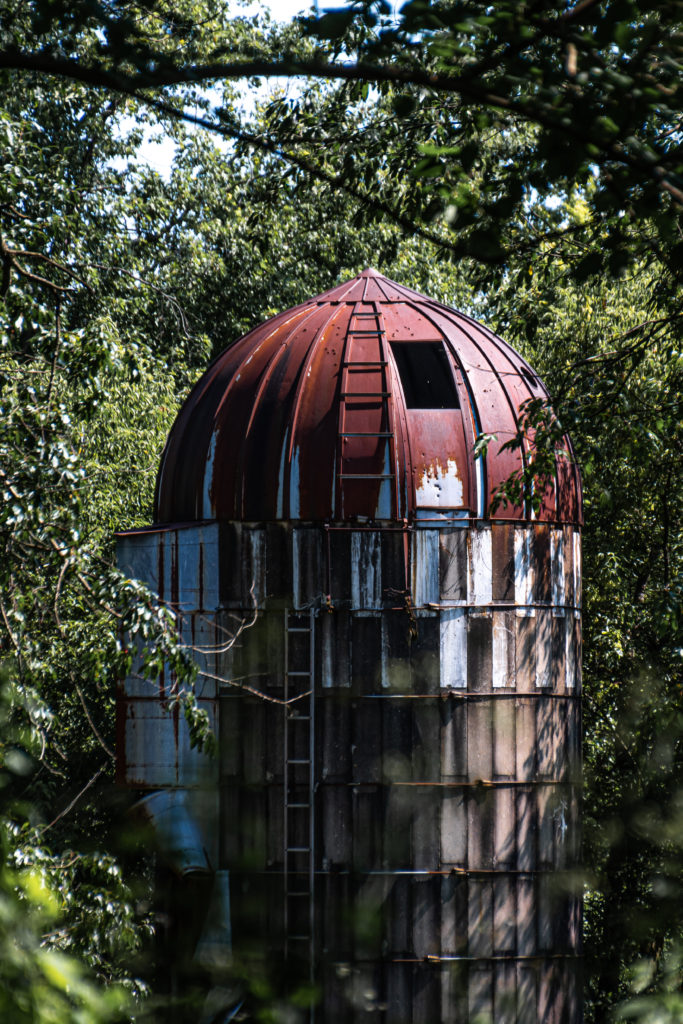
The image may invoke or imply a number of things. But this abandoned silo found along the Verona Segment, Ice Age National Scenic Trail, is a memory vault for me. You can see the ladder on the roof by the open hatch and another coming up the side from below. Ladders are for climbing, right? So that is what I used to do. Our family farm had a very similar silo. There were also rungs on removable doors inside the chute you see on the left of the old silo. Climbed up and down that route, too.
You’re looking at a concrete block silo likely built in the late 40s or early 50s. The concrete blocks were tongue-in-groove so they’d lock together usually with the help of mortar. Rolled steel rods were wrapped around the whole thing and tightened with a type of turnbuckle. Early models used steel roofing but that quickly gave way to aluminum. The chute also is aluminum. (go to page 2)
These silos were built to store cow feed. The Wisconsin landscape was covered with silos of all descriptions and the concrete blocks were popular; simple, available materials, and quickly assembled. Most of the time they were filled with freshly chopped whole-plant corn but also hay crops such as alfalfa and grass. By the time this silo came into service tractors were pulling corn choppers through the fields blowing the silage into wagons. Once filled, the wagons would be unhooked from the chopper and replaced with an empty wagon while the wagon full of silage was pulled to the side of the silo.
At the silo, you’d find another tractor connected to a blower and a pipe that went up the side to the open hatch on the roof. Silage would be dumped out of the wagon into the blower and it’d go up the pipe to the top of the silo and fall inside. Wagon after wagon would be brought up and blown into the silo until the structure was full. As the silage settled on its own weight the silo would get topped off a few times to assure it was full to the brim. The tightly packed, chopped corn then fermented preserving it as feed for the winter.
Climbing up and down the silo during filling got handed off to the youngest people on the farm as soon as possible. Our silo was 40 feet tall if memory serves me. During the course of a day filling silo, you’d make a number of trips up and down those ladders. It was a free climb without any protective harness. Making the last few feet on top of the roof was always the most dizzying but the view was the best in the world.
Getting the silage out of the silo for the cows in the barn below was the next step. The aluminum chute covered a stack of wooden doors going up the side of the silo. You’d put the doors in before you started filling. When it was time to feed cows in the winter, you’d climb to the top of the silo inside the chute using the doors and handles and then climb in on the silage when you got to the top. Then you’d fork enough silage down the chute to feed the cows and sometimes this was done twice a day.
As you forked more silage down to the cows, you’d remove a door at a time and send the door down the chute on a rope. At the end of the season all the doors made a stack somewhere near the bottom of the chute and the silo was then empty. Stick the doors back in and the silo was ready for filling in the fall.
These silos presented hazards. All the climbing was a hazard especially when wet or cold. Machinery, the tractors, choppers, wagons, and blowers, each created a set of hazards for falls, entanglements, and crushing to mention a few.
The chemical reactions of fermentation also created “silo gas.” Silo gas is nitrogen dioxide, an extremely toxic, yellowish-brown gas. During the fermentation process, oxygen combines with nitrates in the corn producing nitric oxide gas. Nitric oxide then combines with oxygen to create nitrogen dioxide. Being in the silo during and shortly after filling was deadly.
And there were molds. On the very top of the silage in a silo, a layer of molds would form anywhere from a few inches deep to a foot or more. Fermentation depends on packing the material tightly but the top few inches wasn’t packed so the mold grew wild. In the winter, you had to remove those first few inches of moldy silage before you could get to the good stuff. “Farmer’s Lung” is a well-known disease resulting from exposure to molds and the toxins produced by molds. A big enough dose of mold and toxins inhaled all at once could kill.
Somehow I survived. Most people did. Somehow. Others didn’t make it. They were often neighbors and friends. Others yet, carried the scars with them. My brother has Farmer’s Lung. It was a long known truism that you can tell when you’re with a group of farmers because so many in the crowd were missing body parts: fingers, hands, arms, legs… At the time, it was normal.

 Follow
Follow